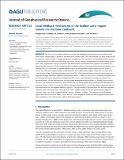| dc.contributor.author | Xue, Pengfei | |
| dc.contributor.author | Eltahir, Elfatih A. B. | |
| dc.contributor.author | Malanotte-Rizzoli, Paola | |
| dc.contributor.author | Wei, Jun | |
| dc.date.accessioned | 2017-06-27T14:24:16Z | |
| dc.date.available | 2017-06-27T14:24:16Z | |
| dc.date.issued | 2014-10 | |
| dc.date.submitted | 2013-12 | |
| dc.identifier.issn | 2169-9291 | |
| dc.identifier.uri | http://hdl.handle.net/1721.1/110303 | |
| dc.description.abstract | The focus of this study is the local-scale air-sea feedback mechanisms over the shallow shelf water region (water depth <200 m) of the Maritime Continent (MC). MC was selected as a pilot study site for its extensive shallow water coverage, geographic complexity, and importance in the global climate system. To identify the local-scale air-sea feedback processes, we ran numerical experiments with perturbed surface layer water temperature using a coupled ocean-atmosphere model and an uncoupled ocean model. By examining the responses of the coupled and uncoupled models to the water temperature perturbation, we identify that, at a local-scale, a negative feedback process through the coupled dynamics that tends to restore the SST from its perturbation could dominate the shallow water region of the MC at a short time scale of several days. The energy budget shows that 38% of initial perturbation-induced heat energy was adjusted through the air-sea feedback mechanisms within 2 weeks, of which 58% is directly transferred into the atmosphere by the adjustment of latent heat flux due to the evaporative cooling mechanism. The increased inputs of heat and moisture into the lower atmosphere then modifies its thermal structure and increases the formation of low-level clouds, which act as a shield preventing incoming solar radiation from reaching the sea surface, accounts for 38% of the total adjustment of surface heat fluxes, serving as the second mechanism for the negative feedback process. The adjustment of sensible heat flux and net longwave radiation play a secondary role. The response of the coupled system to the SST perturbation suggests a response time scale of the coupled feedback process of about 3–5 days. The two-way air-sea feedback tightly links the surface heat fluxes, clouds and SST, and can play an important role in regulating the short-term variability of the SST over the shallow shelf water regions. | en_US |
| dc.language.iso | en_US | |
| dc.publisher | American Geophysical Union (AGU) | en_US |
| dc.relation.isversionof | http://dx.doi.org/10.1002/2013JC009700 | en_US |
| dc.rights | Article is made available in accordance with the publisher's policy and may be subject to US copyright law. Please refer to the publisher's site for terms of use. | en_US |
| dc.source | MIT Web Domain | en_US |
| dc.title | Local feedback mechanisms of the shallow water region around the Maritime Continent | en_US |
| dc.type | Article | en_US |
| dc.identifier.citation | Xue, Pengfei et al. “Local Feedback Mechanisms of the Shallow Water Region around the Maritime Continent.” Journal of Geophysical Research: Oceans 119.10 (2014): 6933–6951. © 2014 American Geophysical Union | en_US |
| dc.contributor.department | Singapore-MIT Alliance in Research and Technology (SMART) | |
| dc.contributor.department | Massachusetts Institute of Technology. Department of Civil and Environmental Engineering | |
| dc.contributor.department | Massachusetts Institute of Technology. Department of Earth, Atmospheric, and Planetary Sciences | |
| dc.contributor.mitauthor | Eltahir, Elfatih A. B. | |
| dc.relation.journal | Journal of Geophysical Research: Oceans | en_US |
| dc.eprint.version | Final published version | en_US |
| dc.type.uri | http://purl.org/eprint/type/JournalArticle | en_US |
| eprint.status | http://purl.org/eprint/status/PeerReviewed | en_US |
| dspace.orderedauthors | Xue, Pengfei; Eltahir, Elfatih A. B.; Malanotte-Rizzoli, Paola; Wei, Jun | en_US |
| dspace.embargo.terms | N | en_US |
| mit.license | PUBLISHER_POLICY | en_US |
